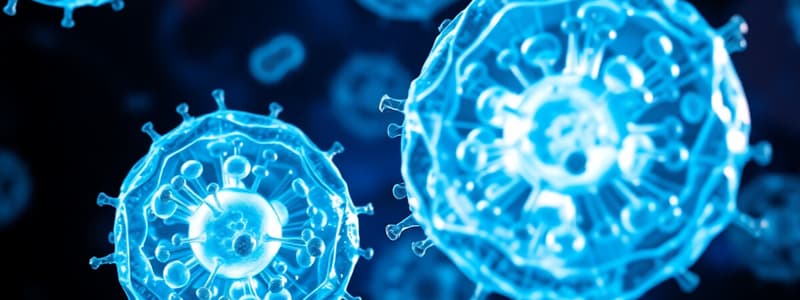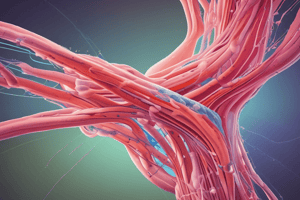Podcast
Questions and Answers
What is the primary function of muscle cells?
What is the primary function of muscle cells?
- To cause movement (correct)
- To produce hormones
- To store energy
- To exchange gases
What structure do muscle cells form when arranged together?
What structure do muscle cells form when arranged together?
- Fibers
- Bundles (correct)
- Tissues
- Threads
Why do muscle cells contain a large number of mitochondria?
Why do muscle cells contain a large number of mitochondria?
- To facilitate cell division
- To store calcium ions
- To synthesize proteins
- To release energy via respiration (correct)
What is the process by which muscle cells generate energy for contraction?
What is the process by which muscle cells generate energy for contraction?
What is a key characteristic of muscle cells that enables movement?
What is a key characteristic of muscle cells that enables movement?
What enables muscle cells to effectively pull on things and cause movement?
What enables muscle cells to effectively pull on things and cause movement?
Which of the following statements about muscle fibers is true?
Which of the following statements about muscle fibers is true?
Mitochondria in muscle cells serve what crucial function?
Mitochondria in muscle cells serve what crucial function?
What is the significance of muscle cells being arranged in bundles?
What is the significance of muscle cells being arranged in bundles?
How do muscle cells utilize energy during contraction?
How do muscle cells utilize energy during contraction?
Flashcards
Muscle Cell Function
Muscle Cell Function
Muscle cells cause movement by contracting and pulling on things.
Muscle Fiber Arrangement
Muscle Fiber Arrangement
Muscle cells are arranged in bundles called muscle fibers.
Muscle Contraction
Muscle Contraction
Muscle cells shorten to cause movement.
Mitochondria in Muscles
Mitochondria in Muscles
Signup and view all the flashcards
Muscle Energy Source
Muscle Energy Source
Signup and view all the flashcards
Muscle Cell Function
Muscle Cell Function
Signup and view all the flashcards
Muscle Fiber Arrangement
Muscle Fiber Arrangement
Signup and view all the flashcards
Muscle Contraction
Muscle Contraction
Signup and view all the flashcards
Mitochondria Role
Mitochondria Role
Signup and view all the flashcards
Muscle Energy Needs
Muscle Energy Needs
Signup and view all the flashcards
Study Notes
Muscle Cell Function
- Muscle cells are specialized cells responsible for generating force and movement.
- Muscle fibers are the arrangement of muscle cells into bundles, with myofibrils being the individual contracting units within muscle fibers.
- Muscle cells require substantial energy for contraction, and their large number of mitochondria provide the energy through cellular respiration.
Muscle Cell Energy Production
- Cellular respiration is the process that converts glucose into ATP (adenosine triphosphate), the primary energy source for muscle contraction.
- Muscle cells store a limited amount of ATP, relying on creatine phosphate as an initial energy source, and then anaerobic respiration and aerobic respiration for long-term energy production.
Muscle Structure and Contraction
- Actin and myosin filaments within muscle fibers slide past each other, creating a shortening movement known as a contraction.
- The striated appearance of skeletal muscle is due to the arrangement of actin and myosin filaments.
- Sarcomeres are the functional units within myofibrils, and their shortening leads to overall muscle contraction.
Muscle Cell Characteristics
- Excitability allows muscle cells to respond to stimuli, which triggers contraction.
- Contractility enables muscle cells to shorten and generate force for movement.
- The bundled arrangement of muscle cells allows for coordinated muscle contractions.
- The myofibrils within muscle fibers are responsible for muscle contraction through the sliding filament mechanism.
- Mitochondria provide the necessary ATP for muscle contraction, playing a crucial role in muscle function.
Studying That Suits You
Use AI to generate personalized quizzes and flashcards to suit your learning preferences.




